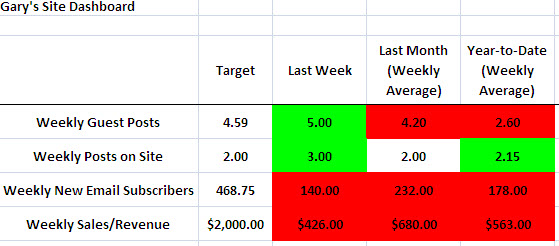This guest post is by Josh Turner of GatewayCFO.com.
If you?re like me, you focus most of your attention on the growth of your site. You know that generating revenue is priority number one. Thinking about finance and accounting? That?s just a distraction.
While this is true to some extent, there is much more to the world of finance than just counting the beans.
Business finance is about using numbers to improve future business performance. In other words, accounting is about understanding the past and finance is about mapping out the future. No matter the size of your business, the same principles can be applied.
Within big corporations, finance departments provide data, tools and analysis to increase future sales, opportunities, and revenue. And you can do the same things.
One way they achieve this is through the use of dashboards or scorecards. These tools monitor the key metrics that their sales and marketing teams have to stay on top of. Not meeting these goals in the short term will cause them to falter down the road. So what does this mean for you?
Monitoring your metrics?and I?m not talking site traffic
Let?s use Gary as an example. Gary is working hard to grow his email list. He?s currently at 500 subscribers, and has a short-term goal of reaching 8,000. He knows that his growth is supported by two areas:
- organic traffic on his site, converting to email signups
- guest posts driving traffic to his site, which convert to email signups.
With his current posting schedule of two new articles per week, Gary expects to receive ten new email signups per week. He also knows that, on average, he receives 100 new email signups every time he writes a guest post.
Using your data to project growth
Based on this data, Gary can figure out exactly what it will take to reach his goals. Initially, he decides that it?s feasible to write a total of four articles per week: two for his site and two guest posts. Based on this level of activity, he can forecast approximately 210 new email signups per week. At this rate, it will take Gary 35.71 weeks to grow his list of 500 all the way to 8,000.
Gary has never looked at his email list growth this way. Not bad, he thinks, but he really had hoped to grow his list to 8,000 within 16 weeks. Based on the same metrics and assumptions, Gary can calculate that he needs to add 468.75 new subscribers every week to reach this goal.
Breaking it down from there, he knows that he will need to write 4.59 guest posts per week. That?s about 238 guest posts on an annual basis. Gary decides to step up his game, put in the hard work, and make it happen.
Looking at list growth in this manner provides clarity and clear goals. But you have to take it a step further to enforce accountability.
Create your own dashboard to improve performance
Big businesses use dashboards to keep owners and managers apprised of performance, and to keep their teams on track and accountable. Typically a graphical display, it shows them the key numbers that they have identified as critical to their business performance.
Doing the same thing for your site and email list will provide you with the same type of accountability. Build a simple Excel spreadsheet that tracks the numbers that you have identified as critical for the growth of your email list. It might contain the following data:
- weekly guest posts
- weekly posts on site
- weekly new email subscribers
- weekly sales/revenue
Set up the spreadsheet to include data for the prior week, prior month, and year-to-date. This will give you insight into your numbers and tell you if you are on track. Gary?s dashboard might look like this:

An example spreadhseet
Use conditional formatting in Excel to highlight good results in green and bad results in red, and set up a second sheet that includes the actual data for each week. With this, you can then create functions within the dashboard that automatically generate the dashboard results. Once this is completed, all you have to do is update the data sheet at the end of each week with the four numbers.
Why would you want to do this?
Spend 30 minutes setting up the Excel file. Following this initial setup, you will only need to spend one minute updating the data each week. Doing so will provide you with tangible benefits.
- You will stay on top of your metrics and not stray from your plan.
- You will be consistently reinforcing your goals.
- When things go astray, you will know where course correction is needed.
- You?ll be executing your business like a pro.
- You will be far more likely to meet your email list goals.
Yes, it?s an extra step in your blogging process. But with just a little time up front, you?ll be running your site and business much more like, well, a business.
Josh Turner is the founder of GatewayCFO.com, where he helps small business owners realize their profit potential. He is currently giving away his how-to ebook ?Cash Flow Clarity: Be Proactive, Make Life Easier, Make More Money.? Get your copy here.
collegeboard kelsey grammer coco rocha coco rocha al sharpton izon heart attack grill
No comments:
Post a Comment
Note: Only a member of this blog may post a comment.